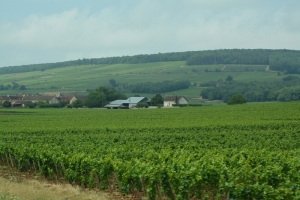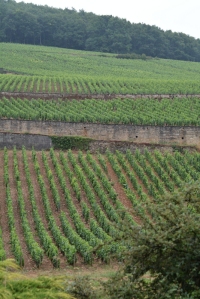“The First Duty of wine is to be Red…the second is to be a Burgundy” – Harry Waugh “There is no other region in the world that can rival Burgundy for purity of expression of single varietal wines made from Chardonnay and Pinot Noir” – Karl Olsen Our time in Burgundy was short lived, only two days, but as the story is told between this blog and the previous one, our time was well spent with great food and tastings and sites of Burgundy, and left us wanting more. Though we were able to taste some wines from the Cote de Nuits, all our time was spent in the Cote de Beaune.
There are two other great Burgundy tastings to tell about, but before I get into that, I need to digress into the reason why the terroir of Burgundy is so special. No information regarding what makes Burgundy great would be complete without a little more discussion on Terroir.  Much of the ensuing information comes from the Bureau Interprofessional des Vins de Bourgogne (BIVB) located in the town of Beaune. 200 million years ago there was a tropical sea over the burgundy area. The multitude of shell fossils contributed to the substantial limestone and the existing marl in the subsoil. The western hills were created by the Alps and ensuing glacial movement through the area. Burgundy is exposed to a semi-continental climate, and the vines sit at altitudes of around 200-500 meters (the mountainous Haute regions are a bit higher). In the summer growing months, the vines benefit from wide temperature fluctuations (50-80 degrees). The growers seem to have moved as organically as possible in their cultivation techniques, even to the point of Biodynamic methods (even Domaine Romanee Conti is biodynamic!). Humans have played a big role in helping the land to achieve its potential in producing great fruit. There is evidence of Gallo-Roman vine cultivation, from the 1st century, up through the 4th century. At the end of the first millennium, the regional Cluniac and Cistercian monks were formalizing early vintnering processes, and in the 15th century, the Dukes of Burgundy greatly expanded the wine’s influence throughout France and Europe. The beginning of the 18th century had Napoleon I, privatizing the vineyard plots away from the church. In 1855, Napoleon III classified Bordeaux in the five-growth classification that is still followed today. The status quo remained pretty much unchanged in Burgundy for almost four hundred years. In 1936, however, the AOC first registered the distribution of the Burgundy Crus, as we know them today. The current cultivating practices in Burgundy are renown for their gentleness in every aspect of winemaking – from the soil to the glass. There is no other region in the world that can rival Burgundy for purity of expression of single varietal wines made from Chardonnay and Pinot Noir.
Much of the ensuing information comes from the Bureau Interprofessional des Vins de Bourgogne (BIVB) located in the town of Beaune. 200 million years ago there was a tropical sea over the burgundy area. The multitude of shell fossils contributed to the substantial limestone and the existing marl in the subsoil. The western hills were created by the Alps and ensuing glacial movement through the area. Burgundy is exposed to a semi-continental climate, and the vines sit at altitudes of around 200-500 meters (the mountainous Haute regions are a bit higher). In the summer growing months, the vines benefit from wide temperature fluctuations (50-80 degrees). The growers seem to have moved as organically as possible in their cultivation techniques, even to the point of Biodynamic methods (even Domaine Romanee Conti is biodynamic!). Humans have played a big role in helping the land to achieve its potential in producing great fruit. There is evidence of Gallo-Roman vine cultivation, from the 1st century, up through the 4th century. At the end of the first millennium, the regional Cluniac and Cistercian monks were formalizing early vintnering processes, and in the 15th century, the Dukes of Burgundy greatly expanded the wine’s influence throughout France and Europe. The beginning of the 18th century had Napoleon I, privatizing the vineyard plots away from the church. In 1855, Napoleon III classified Bordeaux in the five-growth classification that is still followed today. The status quo remained pretty much unchanged in Burgundy for almost four hundred years. In 1936, however, the AOC first registered the distribution of the Burgundy Crus, as we know them today. The current cultivating practices in Burgundy are renown for their gentleness in every aspect of winemaking – from the soil to the glass. There is no other region in the world that can rival Burgundy for purity of expression of single varietal wines made from Chardonnay and Pinot Noir.
“Climats” are precisely delimited plots in the region with particular geological and climactic conditions that help to define the plot’s specific terroir. This differs from “Clos” which is a walled vineyard within a climat that historically belonged to a specific landowner.
Today the walls still exist, but because of inheritance laws it is not unusual to have one vigneron taking care of 4-5 specific rows of vines separate from the next 4 and the next 4, all within one Clos! One last note, it was surprising to learn that no novel yeast is added to the fermentation anywhere here- it is all the natural/native yeast on the skins that begins fermentation. So basically, the Burgundy vignerons rely on immaculate fermentation! Additionally, all red and white wines undergo a secondary malolactic acid fermentation, in order to smooth out the wines. These northern vineyards have naturally higher acidity due to the relatively shorter growing season. The malo fermentation is also a natural process that occurs in the barrels.
We actually pulled off the bungs in the caves and heard the bubbling from the secondary malo fermentation occurring in the barrels!
Now to the last two tastings. Our second vineyard was at Domaine D’Ardhuy, just over the border into the Cote de Nuits. This winery is fully biodynamic, and had impressive caves that dated back to the 1600s. Their vineyards are all over the region, and here is where we tasted our first Grand Cru. I won’t give the details of every wine we tried, at the risk of putting anyone to sleep. The highlights were first a 2008 white burgundy from Pulingy Montrachet “Sous Le Puits”. Light in color, very mineral aromas, and very complex with just a hint of oak tannins. 2008 was a great year for white Burgundy (2009 was best of the decade for red). The second highlight was the 2007 Corton Renardes Grand Cru. Darker in color than any other red we have had, I could really taste what is meant by ‘forest floor’, and ‘preserved fruits’. Not spicy, but overall well balanced. The winemaker told us that this should be drunk now at 6 years old, and not cellared.
The last vineyard we visited was actually a winery operated by a Negociant (Domaine Henri de Villamont). A Negociant is basically a wine merchant in the Savigny les Beaune region, that assembles the finished (or sometimes unfinished) wines from a smaller grower or winemaker, and sells the result under his own name. This gives the advantage to the little guys of sure sales and broader exposure with less risk, no advertising budget, and even not having to buy expensive equipment for wine pressing, bottling, labeling, etc. Henri de Villamont specializes in Grands Vins de Bourgogne. We had our best tastings offered here. These ranged from a 2011 Corton Charlemagne Grand Cru white Burgundy, (which was rich and round, with excellent mineral notes), to a Pommard 1er Cru “Les Rugiens” red burgundy (exceptional preserved black fruit aromas and flavors), to a 2006 Fixin (pronounced “feezaugn”) 1er Cru “Clos du Chapitre” from the Gevery Chambertin area, that was the best red of the day that we tasted. We didn’t get to taste, but I bought several 2009 Grands Echezeaux Grand Cru Burgundies for drinking back home. As an aside, while we were here we witnessed a very tragic occurrence- a hailstorm. There has been hail the last three years, which decimates the grape clusters. The hail was really hard on the Meursault and most of the southern Beaune, but thankfully had minimal effect on the Cote de Nuits. It can be very difficult for the small growers to make a living when your entire years’ efforts are destroyed in 15 minutes! It is easy to see why there are so many US expatriates who have taken up permanent residence in the Burgundy valley and devote their entire livelihood to the wines of this great wine region (i.e. Winehog, Burghound). It has been said before; all wine lovers eventually come home to Burgundy. The 2,000 years of winemaking heritage that exists here is difficult to surpass. I can’t wait for the next time I can come home to this place- next time, Cote de Nuits… stay tuned! That’s all for now. Cheers, Karl







